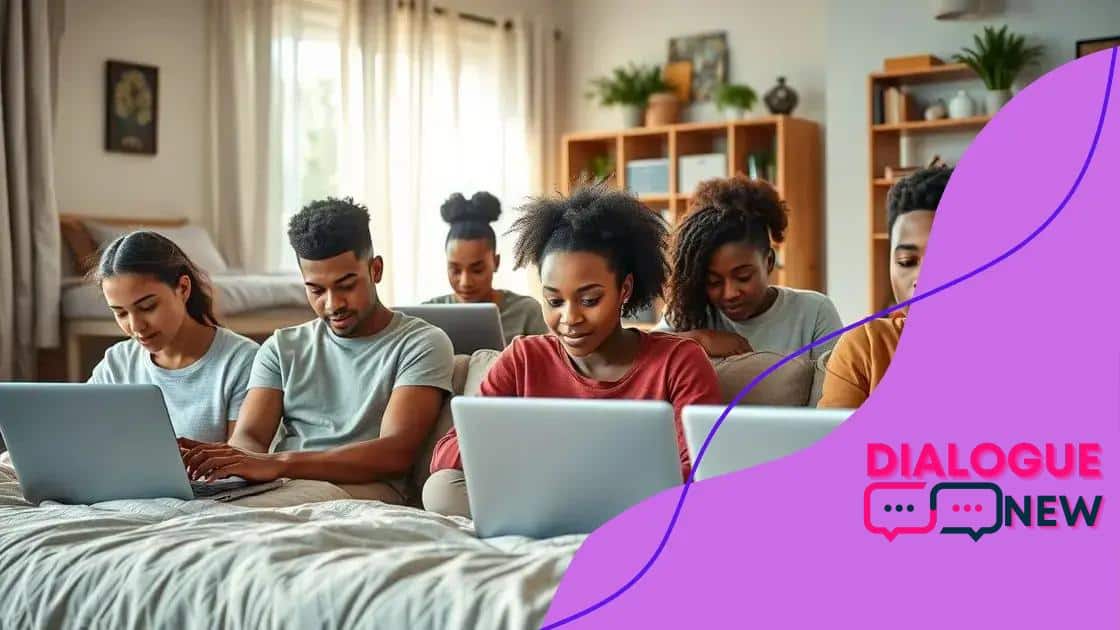Remote learning technologies for global education

Remote learning technologies enhance education by providing increased accessibility, personalized learning experiences through AI, blended learning models that combine online and in-person instruction, and a focus on social-emotional learning for holistic student development.
Remote learning technologies for global education are reshaping how we approach learning across borders. Have you ever considered how these tools impact your education experience? Let’s dive into this exciting evolution together!
The evolution of remote learning technologies
The world of education has seen remarkable changes thanks to the rise of remote learning technologies. These innovations have broken down traditional barriers, allowing students to connect and learn from anywhere. Let’s explore how this evolution has occurred and what it means for global education.
Key Innovations in Remote Learning
Initially, online learning faced skepticism. However, the introduction of tools like video conferencing, learning management systems, and interactive platforms changed the landscape. Many educational institutions began to adopt these technologies, realizing their potential.
- Video conferencing tools like Zoom and Microsoft Teams enable real-time interaction.
- Learning management systems provide resources and track student progress.
- Interactive platforms foster collaboration among students across the globe.
As technology advanced, the solutions became more accessible. Mobile devices brought education into the hands of more learners, enabling them to learn at their own pace. Education is now reachable on smartphones, tablets, and laptops.
Changing Roles of Educators
With the rise of remote learning, teachers have shifted their roles significantly. They are no longer just information providers but also facilitators of learning. This shift encourages critical thinking and active participation. Educators now design engaging lessons that leverage technology, making learning more dynamic.
Engagement is crucial for students. Technologies like gamification and interactive content help maintain interest. These methods allow learners to explore topics in depth while enjoying the process.
A Global Learning Community
Perhaps one of the most significant impacts of remote learning technologies is the formation of a global learning community. Students from different continents can share their experiences and insights, enriching their educational journeys. This diversity fosters understanding and collaboration.
In summary, remote learning technologies are reshaping education. They continue to evolve, making learning more accessible, engaging, and connected. Embracing these changes can lead to a better educational experience for everyone involved.
Key benefits of remote learning in global education
Understanding the key benefits of remote learning in global education is essential as it reshapes how we approach teaching and learning. These advantages are broad, impacting students, educators, and institutions worldwide.
Increased Accessibility
One of the most significant benefits of remote learning is accessibility. Students from remote areas can access high-quality education without traveling long distances. This opens doors for many who may not have had the opportunity otherwise.
- Students can learn from the comfort of their homes.
- Flexible schedules allow learners to balance education with other responsibilities.
- Access to a wider range of courses that might not be available locally.
This increased accessibility promotes equity in education, allowing everyone a chance to succeed regardless of their geographical location.
Enhanced Learning Experience
Remote learning technologies create a more engaging learning experience. With interactive tools, students can collaborate and communicate effectively. This enhances their understanding of the subject matter.
Students can participate in discussions and group projects without the constraints of physical space. This collaboration fosters teamwork and helps students develop essential skills.
Cost-Effectiveness
Remote learning can also be more cost-effective for students and educational institutions. Students save money on commuting, housing, and materials. Schools can reduce expenses related to maintaining physical facilities.
Additionally, online resources often come at a lower cost when compared to traditional textbooks. These savings can make education more affordable, promoting continued learning.
Preparation for the Future
Preparing students for the job market is another crucial benefit of remote learning. Many careers today require digital skills and the ability to work independently. Remote learning cultivates these skills through its emphasis on technology and self-directed study.
Students who can navigate online tools effectively are better prepared for modern workplaces. They also learn to manage their time and seek resources independently, essential skills for success.
Challenges of implementing remote learning

Despite its numerous advantages, implementing remote learning comes with several challenges that need to be addressed for successful educational experiences. Understanding these obstacles can help educators, students, and institutions navigate the complex world of online education more effectively.
Technology Access and Reliability
One of the primary challenges of remote learning is ensuring all students have access to reliable technology. Not everyone has a computer or a stable internet connection, which can hinder learning. This digital divide often varies between urban and rural areas.
- Students may struggle to attend classes if their technology fails.
- Many families cannot afford high-speed internet, impacting learning opportunities.
- Schools must find ways to provide resources for students without adequate technology.
Additionally, technical difficulties during lessons can disrupt learning and frustrate both teachers and students.
Student Engagement and Motivation
Another significant challenge is keeping students engaged and motivated in a remote setting. Traditional classroom dynamics, such as face-to-face interaction and physical presence, are lost in an online environment.
Without direct supervision, some students find it difficult to stay focused. They may become distracted by their home environment or lack structure. Educators must develop new strategies to foster motivation.
Workload for Educators
Teachers face their own set of challenges when transitioning to remote learning. The workload often increases as they have to create online materials, conduct classes, and provide assessments—all while managing technical issues.
Transitioning to digital platforms requires significant preparation and ongoing support. Teachers may need to learn new software and tools, which can be overwhelming. Professional development and training are essential to ensure educators feel confident in their skills.
Social Interaction Concerns
Social interaction is a critical component of education that is challenged by remote learning. Students miss out on connecting with their peers, which can impact their social development. Remote learning creates isolation and can affect mental health.
It’s important for educators to find ways to encourage collaboration and interaction among students, even in a virtual environment. Virtual group projects and online discussions can help bridge this gap.
Best practices for engaging students online
Engaging students online can be challenging, yet implementing best practices can significantly improve their learning experience. Effective strategies foster motivation and participation, creating a rich educational environment.
Interactive Learning Experiences
One of the most effective ways to engage students is through interactive learning experiences. Instead of passive watching, students should actively participate in their education. This can be achieved by incorporating various online tools and techniques.
- Use polling and quizzes to create instant feedback.
- Incorporate breakout sessions for group discussions.
- Utilize interactive videos that require viewer input.
Such strategies not only keep students engaged but also help them retain information better.
Personalized Learning Paths
Another critical approach is to develop personalized learning paths. Recognizing that each student learns differently, providing tailored experiences can make a big difference. Teachers can assign projects or activities based on individual strengths and interests.
Offering choices empowers students, enabling them to take ownership of their learning. This autonomy encourages motivation and helps them feel more connected to the material.
Open Communication Channels
Establishing open communication channels is vital for online engagement. Students must feel comfortable reaching out to teachers and peers. Utilize forums or discussion boards to facilitate interaction.
Regular check-ins can enhance relationships and provide support. Encourage students to voice their opinions and seek help when needed. Building a supportive online community fosters a better learning experience.
Use of Multimedia Resources
Incorporating multimedia resources in lessons can also enhance engagement. Videos, podcasts, and infographics make learning more dynamic and appealing. Mixing different formats caters to diverse learning styles.
Moreover, using real-world examples and case studies makes content more relatable. This relevance helps students see the purpose behind their studies, enhancing their interest and commitment.
Overall, by applying these best practices, educators can create a more engaging online learning environment. With thoughtful strategies, they can inspire students and cultivate a love for learning even in a remote setting.
Future trends in remote learning technologies
The landscape of remote learning technologies continues to evolve rapidly. As we look to the future, several trends are shaping how education is delivered and experienced worldwide. Understanding these trends can help educators and institutions stay ahead of the curve.
Increased Use of Artificial Intelligence
Artificial intelligence (AI) is making waves in education, and its role in remote learning is expected to grow. AI can personalize learning experiences by adapting content to meet individual student needs. This customization allows for a more tailored approach, helping students learn at their own pace.
- AI-driven tutoring systems can provide instant feedback.
- Chatbots can answer student queries at any time.
- Predictive analytics can identify students who may need additional support.
This technology not only enhances learning but also saves valuable time for educators.
Enhanced Virtual and Augmented Reality
Virtual Reality (VR) and Augmented Reality (AR) are set to transform the online learning experience. These technologies can immerse students in interactive environments, making difficult concepts easier to understand. For example, history lessons can come alive through virtual tours of ancient civilizations.
By creating engaging simulations, students can interact with content on a deeper level, fostering better retention of knowledge.
Blended Learning Models
The future of remote learning will likely see a rise in blended learning models, which combine online and face-to-face components. This hybrid approach allows students to benefit from the flexibility of online courses while still experiencing the social aspects of traditional classrooms.
Such models can cater to different learning styles, providing a more comprehensive educational experience. It also prepares students for a variety of workplace environments, as many jobs now require collaboration in both remote and in-person contexts.
Focus on Social-Emotional Learning
As remote learning becomes more widespread, there will be a significant emphasis on social-emotional learning (SEL). Recognizing the importance of mental health and interpersonal skills, educators will integrate SEL into their curriculums. This approach fosters resilience, empathy, and communication skills among students.
By prioritizing SEL, schools can create supportive environments that enhance students’ overall well-being and academic performance.
In summary, the future of remote learning technologies is bright and full of innovations. By incorporating AI, VR, blended learning models, and a focus on social-emotional skills, education can evolve to meet the needs of all students in a dynamic and engaging way.
In conclusion, the future of remote learning technologies is full of exciting possibilities. As educators, students, and institutions adapt to these changes, they can create more engaging and effective learning environments. By embracing innovations like artificial intelligence, virtual reality, and blended learning models, education can become more personalized and accessible. Additionally, focusing on social-emotional learning ensures that the holistic development of students is prioritized. Together, these trends pave the way for improved educational experiences that prepare students for a successful future.
FAQ – Frequently Asked Questions about Remote Learning Technologies
What are the main benefits of remote learning?
Remote learning offers increased accessibility, flexibility, and personalized education options for students worldwide.
How does artificial intelligence enhance remote learning?
AI provides personalized learning experiences by adapting content to meet individual student needs and offering real-time feedback.
What is blended learning and why is it important?
Blended learning combines online and face-to-face instruction, allowing for a more interactive and engaging educational experience.
How can social-emotional learning be integrated into remote education?
Integrating social-emotional learning can be achieved through activities that promote mental health awareness, collaboration, and emotional well-being in students.





